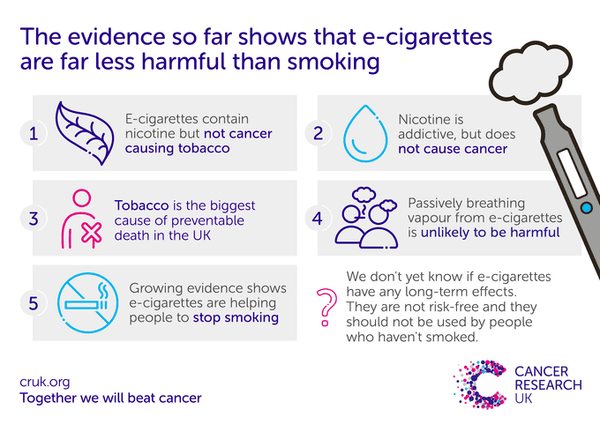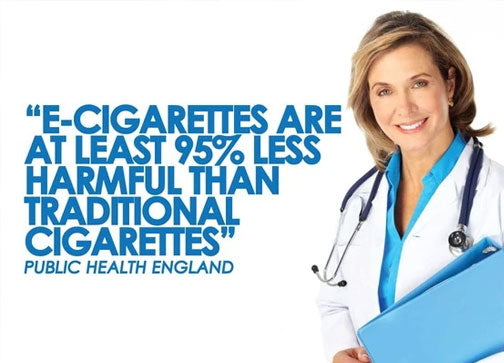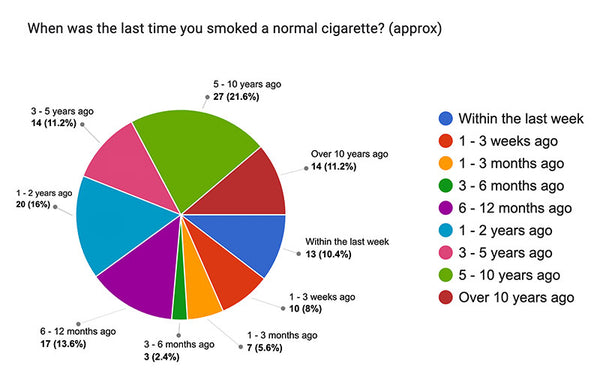*2024 Update - The next generation SMOKO device is here, with our great-tasting UK-made liquids in a pre-filled pod style vape - the SMOKO VAPE POD!
New technology invariably comes with risks and unknowns, and vaping technology is no different. We are finding our way with vaping tech, but we have seen lots of promising results in areas regarding the comparative harm of e-cigarettes and smoking, despite some of the sensationalist articles that have claimed e-cigarettes are just as dangerous as tobacco cigarettes.
One of the concerns about e-cigarettes is the ‘gateway effect’ - the idea that e-cigarettes will actually encourage people to start smoking. Despite the FDA’s Tobacco Control act designed to restrict marketing and sales of tobacco products to youth, this idea may have some validity, for a number of reasons.
VAPING VS SMOKING: WHY IS A VAPE CONSIDERED TO BE THE SAFER ALTERNATIVE TO SMOKING?
The original thinking behind the e-cigarette was as a method of delivering nicotine in a similar fashion to smoking, but with as many of the nasty chemicals removed as possible. There have been many attempts at creating electronic cigarettes, but the version we know today was invented by Hon Lik, a pharmacist from China whose father died from smoking.
The mixture is heated into an aerosol (misnamed vapour) which is inhaled, where the nicotine is absorbed in the lungs. The key here is that the mixture is heated, not burned - this means the levels of harmful particles created are significantly less than those created by burning tobacco.
Burning tobacco also generates carbon monoxide, a substance that sticks to red blood cells, reducing the amount of oxygen they can transport. Tar is another product of burning tobacco, and this clogs up the lungs and prevents the cilia - little hair-like organelles - working to remove debris from the lungs.
It is due to the mounting evidence, studies and clinical trials that has led to Public Health England’s latest evidence review to conclude that e-cigarettes are around 95% less harmful than traditional tobacco cigarettes, and this is supported by the Royal College of Physicians expectation that the damage from electronic cigarettes is unlikely to exceed 5% of the damage from combustible tobacco.
WHAT ARE THE BENEFITS OF VAPING?
The benefits of vaping definitely include less damage done to your health, and cigarette users who make the switch will see improvements to their vascular health within a single month, but the improvements don’t stop there!
Normally, when quitting tobacco products, smokers find they develop the aptly named ‘smoker’s cough’ - the cilia in the lungs working hard to clear the debris.
One study investigated when cigarette smokers stop smoking using nicotine replacement therapy (NRT) versus vaping, and the vaping group experienced less phlegm production and coughing over the year compared to using NRT. (1)
One of the most noticeable benefits from quitting smoking is the money you save! Vaping is much more cost effective than cigarettes - a single pack of 20 cigarettes in the UK costs between £9.73 and £13.60, so for a heavy smoker this is the minimum you would spend per day.
In comparison, a single cig-a-like refill at the highest strength available is equivalent to around 30 cigarettes worth of nicotine. Typically, a heavy smoker using an e-cigarette could expect to spend £2.00 a day. Comparing that to traditional cigarettes, that is a potential saving between £8 to £11 a day, making e-cigarettes almost 80% cheaper!
HOW DOES VAPING HELP SMOKERS QUIT?
Studies on the success rate of e-cigarettes as a smoking cessation tool have indicated that e-cigarettes could be almost twice as effective as other forms of nicotine replacement therapy, when accompanied by behavioural support. (2)
In addition, the Journal of the American College of Cardiology conducted a study in which the vascular health of smokers who switched to vaping was studied and concluded that after a single month, significant improvements were made in endothelial function (the lining of the blood vessels controls their ability to constrict and dilate). (3)
According to the UK government evidence summary on Vaping in England, 2017 saw over fifty thousand smokers quit tobacco with a vaping device, and in 2020, over a quarter of all smokers used an electronic cigarette in their quit attempt. (4)
IS VAPING SAFE?
Vaping is considered to be safer than smoking due to the nature of the aerosol we inhale into our lungs: exhaled e-cigarette aerosol is 99.9% vegetable glycerine and water, compared with Baker and Proctor’s estimate that exhaled environmental tobacco smoke contributes between 3 and 11% of carbon monoxide, between 15 and 43% particles, and between 1-9% nicotine. (5)
One study examined the contents of machine generated e-cigarette aerosol (so hasn’t passed through a set of lungs) and when examining the particulate content of this aerosol in an enclosed space, found that the particulates did not exceed background levels. This suggests that the levels of harmful chemicals made in the generating of e-liquid aerosol are so small that it is almost in line with particulates we would expect to see in normal air.
So by all accounts, e-cigarettes are a safer bet than tobacco cigarettes!
WHAT DO THE STUDIES ON VAPING SAY?
When it comes to evidence for vaping acting as a gateway for smoking, a 2018 analytical review examined 15 studies on vaping as a gateway to smoking in young people, and how well confounding factors were accounted for. The review concluded by saying that a true gateway effect had not been demonstrated, that the list of smoking predictors in all studies was not comprehensive, failing to include important factors like parental smoking, outcome expectancies, school performance and anxiety. (6)
A separate 2021 meta analysis showed an association between ‘ever-use’ of electronic nicotine delivery system (ENDS) and ‘ever-use’ of cigarettes - this means if you’ve tried vaping, you will likely have tried smoking - but in current vapers, there is a significant association with ‘ever-use’ of cigarettes, but not current cigarette use. This suggests that, at least in the long term, e-cigarette users do not end up smoking cigarettes. (7)
These results are expected, as the youth and young adults typically experiment at that age: if someone has tried either cigarettes or e cigarettes, they are likely to try the other. This could be down to the similarities between vaping and smoking, a less acute awareness of the damage done by smoking, or a number of other factors.
*2022 Update - We conducted a study on over one hundred SMOKO customers and found that 60% of those asked hadn't had a cigarette in a year and an additional 13.6% hadn't smoked in the last 6 months! Check out the chart below for our results!
THE VERDICT: ARE E-CIGS A GATEWAY TO SMOKING?
The problem with e-cigarettes and the youth is not e-cigarettes themselves, but rather the marketing of them. In the US, many of the e-liquid flavours available were named with youth appeal; bright, colourful, abstract words that didn’t so much reference a flavour as an exciting idea. According to the CDC, in 2021 middle and high school students that vaped used mostly fruit flavours at 71.6%, followed by dessert and sweet flavours at 34.1%.
The Food and Drug Administration issued warning letters in July 2020 to retailers that sold e-liquids with packaging that appeals to youth - flavoured e cigarettes imitating food packaging marketed toward kids, with fun names and characters on. The regulations put in place meant that all unauthorised flavoured e cigarettes (except tobacco and menthol flavours) were now illegal.
According to ASH (Action on Smoking and Health) smoking rates in the youth population (11-15 years) of the UK has been steadily declining since 1982, from 25% in 1982 down to 5% in 2018.
The e-cigarette has been available in the UK from 2005 - albeit early generation devices that are obsolete by today’s standards - and the decline in youth smokers from 2006 to 2018 was from 20% down to 5% - so in the time that e-cigarettes have been available, the youth smoking rates in the UK have continued to decline. This suggests that the idea that e-cigarettes are a gateway to smoking is incorrect, at least here in the UK.
ARE E-CIGARETTES A GATEWAY TO SMOKING? HERE’S THE TRUTH - CONCLUSION
In the UK, all of the research, studies and reports have found there is no evidence that e-cigarettes are a gateway to smoking cigarettes in the future. In fact, the rate of youth smoking has reduced by 4x from 20% down to 5%.
With the
stringent laws in the UK relating to the sale of e-cigarettes to people under the age of 18 year old is another deterrent to preventing under age vaping.
Given that e-cigarettes have been proven to be 95% less harmful than cigarettes and they are up to 80% cheaper, it would be illogical and counterintuitive to believe that people who vape would then move to something that is far more unhealthy and 5 times more expensive.
So from a high level point of view, e-cigarettes are safer, more affordable and do not contain the
4,000 chemicals or 50 known carcinogens found in traditional tobacco cigarettes. Why some media outlets continue to suggest vaping as a gateway to cigarettes seems both misleading and unproductive in the global move to eliminating cigarette use.
If you are still smoking cigarettes and are looking for a way to quit, here are some of our most
popular vape and e-cigarettes that have helped thousands of adult smokers to kick the habit for good!
REFERENCES
(1) A Randomized Trial of E-Cigarettes versus Nicotine-Replacement Therapy
(2) E-cigarettes nearly twice as effective as nicotine-replacement therapy to stop smoking, study finds
(3) Cardiovascular Effects of Switching From Tobacco Cigarettes to Electronic Cigarettes
(4) Vaping in England: 2021 evidence update summary
(5) Tobacco Smoke and Involuntary Smoking: Composition, Exposure and Regulations
(6) Considerations related to vaping as a possible gateway into cigarette smoking: an analytical review
(7) Association between electronic nicotine delivery systems and electronic non-nicotine delivery systems with initiation of tobacco use in individuals aged < 20 years. A systematic review and meta-analysis
ABOUT THE AUTHOR
Written by Dan Overgage
Dan Overgage is a former smoker of 10 years until he became a client of SMOKO E-Cigarettes. Dan started working with SMOKO 5 years ago after successfully quitting using our e-cigarettes and works across our Customer Service and heads up our content creation and research with a strong focus on all things quitting smoking. During his tenure with SMOKO, Dan has written countless blogs and consults with countless clients every day to help them to stay smoke-free.
















